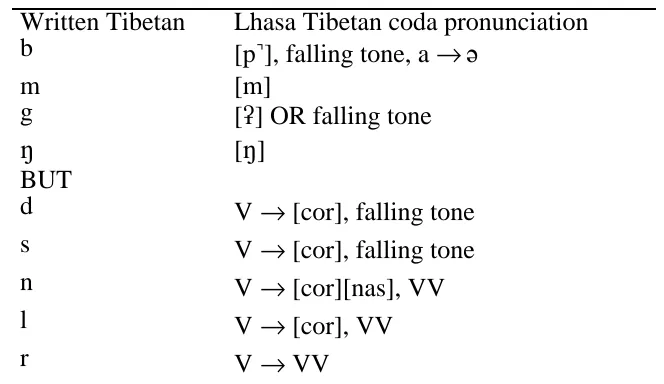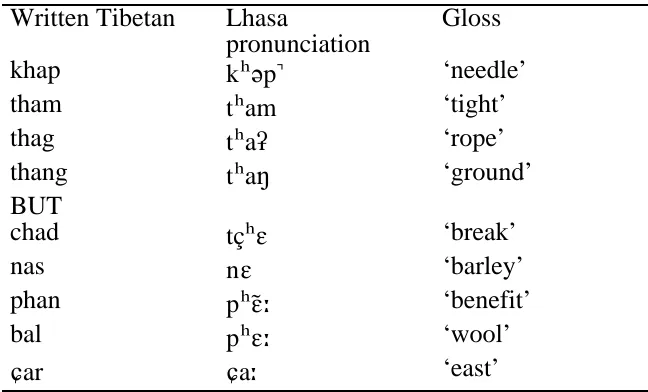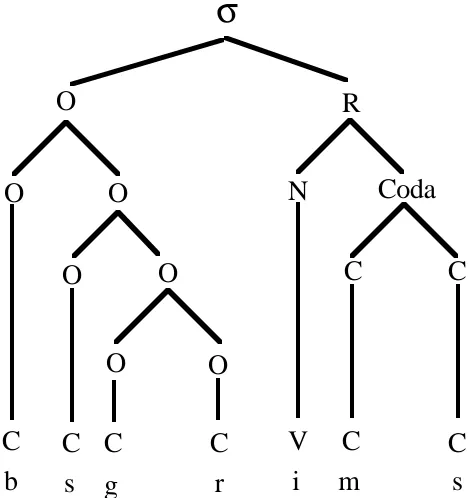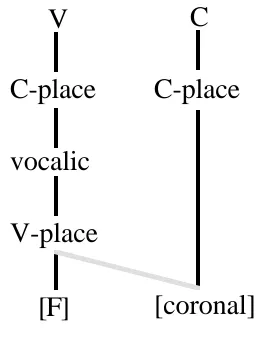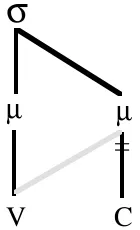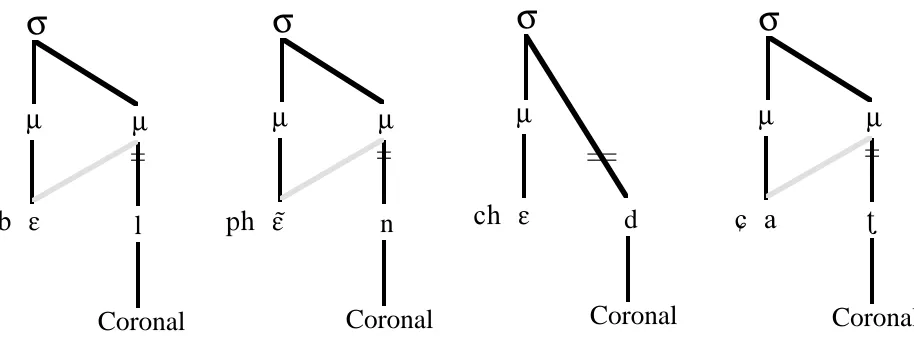1
Copyright © 1997 Beaumont Brush and Summer Institute of Linguistics, Inc. All rights reserved.
First presented at the 24th Annual Meeting of the Linguistic Association of the Southwest, University of New Mexico at Las Cruces, October 6-8, 1995.
The Status of Coronal in the Historical Development
of Lhasa Tibetan Rhymes
Beaumont Brush
Contents:
Abstract
1. Introduction
2. Comparing Written Tibetan and Lhasa Tibetan
3. Data
4. Analysis
5. Coronal markedness
6. Conclusion
References
Abstract
1. Introduction*
This paper examines the development of Coronal segments in the Lhasa Tibetan syllable coda from a diachronic perspective. I use Written Tibetan as evidence for the historically antecedent forms of words and compare them with phonetic forms in the modern spoken dialect of Lhasa Tibetan (or simply “Lhasa”). Although the pronunciation of words in Tibetan dialects has changed, the script has not changed since the ninth century, nor has the way the script is used to represent words. Consider the word glossed as ‘fame’ from Written Tibetan: /grags/. While the word used to be pronounced straightforwardly as [grags], its pronunciation in Lhasa Tibetan is [ÿHa] (Beyer 1992). The principles on which the comparison between Written Tibetan and Lhasa Tibetan (or simply “Lhasa”) is based will be explained in detail in the following section. For now, note the difference between the forms. These differences between orthographic and surface phonetic forms are most often merely described on a segment-by-segment basis as the “effects” of certain script letters on the pronunciation of the word. Such a description, however, makes no reference to natural classes of sounds or phonological processes that have led to the observed
differences. An exception to this trend is the treatment of dentals occurring in the coda, which have been analyzed as a class (Michailovsky 1975, Hume 1992, inter alia).
I propose an analysis that more fully explicates the historical sound changes associated with dentals in the Lhasa Tibetan coda by (i) extending the place of
articulation from dental to Coronal; (ii) extending the motivation for the sound changes from the segmental domain of features into the prosodic domain of the syllable; (iii) characterizing the interaction of and tension between constraints present in the rhyme, namely, the historical syllable simplification process versus the retention of
morphological contrast; (iv) exploring the implications of Coronal markedness for the data and the implications of the data for Coronal markedness. My analysis argues that Coronal in Lhasa Tibetan is underspecified according to modified contrastive
underspecification (Avery and Rice 1989) and not according to universal Coronal underspecification as proposed by other researchers (Paradis and Prunet 1989, 1991). Following the analysis, the Coronal underspecification issue is covered in section 5.
* A version of this paper was presented at the 24th Annual Meeting of the Linguistic Association of the Southwest, University of New Mexico at Las Cruces, October 6-8, 1995; thanks to those in attendance who offered comments. This paper has also been accepted for publication in
University of Texas at Arlington Working Papers in Linguistics, to appear; thanks to the editors
2. Comparing Written Tibetan and Lhasa Tibetan
By comparing the script of Written Tibetan with the pronunciation of Lhasa Tibetan, a modern spoken dialect, we can detect distant shifts that have occurred in the language’s phonology. At its inception in the seventh century, the Tibetan script was largely
phonetic, comprising 30 consonants, four overt vowels, and one unmarked default vowel, the [a]. Pronunciation was fairly straightforward. The same script, revised in the ninth century, is still in use by literate Tibetans today, with no change in the spelling of words. Previous forms of words in Tibetan have thus been preserved orthographically in written Tibetan, although modern Lhasa pronunciation is quite different.
Returning to our example from the introduction, the segments in /grags/ each represent a Tibetan script letter. The letters are in turn referred to according to their position relative to the “root” letter of the syllable1 (Goldstein 1993): the [r] is considered the root letter, with a [g] being “prefixed” and the [a] being the underlying vowel. The [g] and [s] in coda position are referred to as the “suffix” and “post-suffix,” respectively. As mentioned before, the script at one time represented a fairly straightforward encoding of symbol and sound. A modern Lhasa speaker, however, will pronounce it as [ÿHa].
As Tibetan has evolved and diverged into several spoken dialects, its script letters have been reinterpreted by literate Lhasa speakers as “effects” of the script letters on the pronunciation of the word. This characterization of script letters as having an “effect” on pronunciation is helpful for the learner of Written Tibetan to associate written symbols with non-analogous spoken output. It is, however, misleading to characterize script letters that way in phonological analysis. For example, an /m/ in a syllable coda is seen as a suffix that adds an [m]; or an /n/ in the coda is seen not as the phoneme /n/ but as a suffix that fronts, lengthens, and nasalizes the vowel. If one conceives of script letters in this way, it sounds as though the [m] and the [n], being “suffixes” that have “effects,” are part of the lexical component of phonology, which they are not. For this reason, I will depart from the usual pedagogical manner of referring to orthographic elements (Goldstein 1993, Beyer 1992) and instead refer to codas and rules of pronunciation2 . Table 1 exemplifies the rules of pronunciation that Lhasa-speaking readers of Written Tibetan associate with the segments that may occur in the coda position of a syllable.
1 See Goldstein (1993) and Beyer (1992) for discussion of the Tibetan orthography.
Table 1. Pronunciation of Written Tibetan segments in Lhasa Tibetan codas
Written Tibetan Lhasa Tibetan coda pronunciation b [p|], falling tone, a → «
m [m]
g [?] OR falling tone
N [N]
BUT
d V → [cor], falling tone
s V → [cor], falling tone
n V → [cor][nas], VV
l V → [cor], VV
r V → VV
Because the coronal series /-d, -s, -r, -l, -n/ is present in the codas of Written Tibetan words, we can infer that at one time coronals were pronounced in the syllable coda.
Coronals, however, do not occur in the syllable codas of the speech of Lhasa speakers. Table 1 illustrates that written [b, m, g, and N] are pronounced in the codas of Lhasa, while the coronal series [-d, -s, -r, -l, -n] are not. Instead, the coronals are reinterpreted as rules of pronunciation that affect the vowel quality of the syllabic nucleus. For example, the written /r/ is not pronounced in the Lhasa coda; instead, it is seen as a rule of
pronunciation that lengthens the nuclear vowel.
My goal in the following sections is threefold: to present data that will exemplify the differences between codas in Written Tibetan and Lhasa Tibetan (section 3), to propose an analysis of the special behavior of coronals as a class in the development of the Lhasa Tibetan coda (section 4), and to examine the implications of both the data and the analysis so constructed for Coronal underspecification theory (section 5).
3. Data
Table 2. The pronunciation of Written Tibetan words in Lhasa Tibetan
Written Tibetan Lhasa
pronunciation
Gloss
khap kH«p| ‘needle’
tham tHam ‘tight’
thag tHa? ‘rope’
thang tHaN ‘ground’
BUT
chad tçHE ‘break’
nas nE ‘barley’
phan pHE)ù ‘benefit’
bal pHEù ‘wool’
þar þaù ‘east’
Of all the possible segments that may occur in the coda position of Written Tibetan, /b, m, k, N, d, n, r, l, s/ (where the /r/ is retroflex), only the labial and dorsal segments [b, m, k, N] have remained and may be pronounced, as seen by their realization in the codas of the Lhasa words [kH«p|], [tHam], [tHa?], and [tHaN]. The coronals /d, n, r, l, s/ are not pronounced, as seen by their absence in the codas of the Lhasa words [tçHE], [nE], [pHE)ù], [pHEù], and [þaù], despite their presence in the Written Tibetan codas.
Out of consideration for space the [a] is the only vowel represented in the Written Tibetan column, but the Written Tibetan non-front vowels [u,o,a] all undergo fronting to [y,ø,E] respectively. Table 2 highlights the fact that coronals not only are no longer pronounced in the coda, but they also have altered the vowel quality of the nucleus: in some cases the coronal has caused the vowel to front (/nas/ → [nE] and /chad/ → [tçHE]), in some cases it has caused the vowel to lengthen (/þar/ → [þaù]), in some cases it has caused both (/bal/ → [pHEù]), with the addition of nasalization in one case (/phan/ → [pHE)ù]). In the next section I present an analysis that explains why the coronals in the codas behave differently than the non-coronals. Furthermore, the analysis accounts for the fact that not all coronals participate in the processes in exactly the same way.
the vowel. For example, the /p/ causes some very selective fronting and raising. While there are conflicting reports on the variable status of the other finals in Lhasa Tibetan, the coronals consistently affect the vowel quality and are not pronounced.
4. Analysis
In accounting for the data here, I present the relevant historical processes and constraints that have emerged and conspired to produce these surface forms. I also explain the
reasons for the varying behavior of coronals in the processes as a result of the presence of other features in the coronal segments, such as sonority, nasality, and retroflexion. The constraints proposed here are not considered to have appeared suddenly and targeted all affected segments simultaneously, but are considered to have emerged slowly and incrementally, affecting more frequently occurring segments and words first, and eventually spreading throughout the language.
The following analysis characterizes the historical process by which the Lhasa Tibetan syllable has eroded (4.1), with a current constraint in Lhasa Tibetan against coronals in the syllable coda (4.3). Morphological contrast has not been lost with the loss of the coronals, however, because of a Coronal Assimilation from coda to nucleus (4.2) and a subsequent Compensatory Lengthening of the nuclear vowel (4.4). Subsections cover the reasons for the varying behavior of certain coronals in each process, and
derivations (4.5) demonstrate graphically how the processes affected the data from Table 2. Finally, section 5 discusses the implications of the analysis of Coronal
underspecification theory and argues that Coronal is not radically underspecified in Lhasa Tibetan.
4.1 Syllable simplification
The first factor contributing to the phenomena illustrated in Table 2 is the historic Syllable Simplification process in Tibetan, as described by Geziben (1995). The Tibetan syllable has gradually developed from a CCCCVCC template in Ancient Tibetan, still observable in Written Tibetan, to CVX in Lhasa Tibetan, where X may be either a consonant or vowel.
The Ancient Tibetan syllable template in Figure 1 shows the maximal Tibetan syllable at that time, with four onset slots and two coda slots, as in the word bsgrims, which is glossed ‘twist with finger.’ Over time the constituents of this template have eroded away, with various sound changes emerging to preserve contrast. The modern Lhasa Tibetan reflex of Figure 1, as shown in Figure 2, is now a CVC syllable,
pronounced [t§im]. Because the Tibetan syllable has consistently tended toward
simplification, I include the simplification process among the other processes outlined in this section that are present and that conspire to produce the surface forms under
other. In light of the simplification process, I place the domain of the constraint against coronal codas within the prosodic domain of the syllable.
b
s
g
r
V
i
m
s
Coda
C
C
O
O
O
O
O
O
C
C C
C
C
C
N
R
σ
O
Figure 1. Ancient Tibetan Syllable Template
σ
R
N
C
O
C
V
(X) where X=(C, V)
t§
i
m C={Labial, Dorsal}
Figure 2. Lhasa Tibetan Syllable Template
the segmental constituents of the syllable have changed quite dramatically, the weight of the syllable has remained maximally bi-moraic and optionally mono-moraic3; see 4.4 for further discussion of the relevance of syllable weight.
4.2 Coronal Assimilation
At some point in the history of the language the non-front vowels in the nucleus became fronted. This phenomenon has typically been treated as the assimilation of the vowel to the [–back] of the coda consonant. However, following the feature geometry proposed by Clements and Hume (1995), an assimilation of this sort is more accurately characterized as the coronalization of the vowel, in that the relevant feature that spreads is not [–back], but Coronal. As both Hume (1992) and Odden (1991) have pointed out, the spreading of the feature [–back] is not a straightforward account of the effect of coronal consonants on preceding non-front vowels, because if that were the case all coronal consonants would have to be specified for [–back], which is a vocalic feature. Furthermore, [back] is
typically located under the dorsal Place node. For this reason, the interaction between the coda and the nucleus in these data is characterized as a Coronal Assimilation, as shown in Figure 3.
V
C
C-place
vocalic
V-place
[F]
C-place
[coronal]
Figure 3. Coronal Assimilation
Under this analysis the structure of vowels and consonants is slightly different than geometries that do not allow vowels and consonants to share place features. This
geometry (Clements and Hume 1995) proposes the addition of the Vocalic and V-place nodes for vowels. Place features are shared by vowels and consonants, and each place feature is on its own tier, which allows for a straightforward representation that explains why the non-front, or Dorsal nucleus became fronted before a coronal consonant: Coronal can spread from coda to nucleus, and from consonant to vowel. This association,
reflecting the right-to-left directionality parameter of the syllable, adds Coronal to the specification of the vowel, making it a front vowel. Additionally, there is a standard nasal assimilation. In this model, [nasal] is a dependent of the root node, and so associates from the coda to the root node of the nucleus.
The question that could now be asked is: does Coronal associate to the vowel as a faithfulness strategy in response to the restriction against Coronal, or does the restriction against coronals remove the coda because the vowel has become an allophonic coronal vowel and the coda is therefore redundant? If the following phonetic basis of the Coronal Assimilation is considered along with the Syllable Simplification process, there is a
natural motivation for the latter ordering of events. I will characterize these events as the Coronal constraint (4.3) working in concert with Syllable Simplification to unlicense coronal codas in response to the Coronal Assimilation.
The phonetic motivation for the assimilation is provided by Michailovsky (1975). A major factor of stop recognition is the formant frequency transition from the preceding vowel. Before the dental series [-d, -n, -l, and -s], non-front vowels “have rising F2 transitions, which corresponds to movement forward in the vowel space” (327). The transition subsequently phonologized in Lhasa, with the transition itself emerging as the reinterpreted contrastive feature of the nucleus. Hari (1979) notices that the only front vowels that occur in the speech of Lhasa Tibetans are before orthographically coronal codas. She argues that although front vowels are contrastive in speech, they are front allophones of non-front vowels followed by orthographic coronal codas. Phonologically, her position supports the representation of the Coronal place spreading to the vowel. The phonologization of the F2 transition corresponds to the assimilation of Coronal, a front-space feature. A hypothesis following from this characterization of the assimilation is that once the contrast that the coda provided was encoded on the nucleus in the front vowels, the Coronal Edge Constraint (4.3) was free and perhaps more likely to occur because of the redundancy of the coronal coda as against the nucleus, which had assimilated Coronal as a result of Coronal Assimilation.
4.2.1 Retroflexion
Although the retroflex /r/ does participate in other processes that target coronals, it does not participate in the assimilation, so /chad/ → [tçHE] but /þar/ → [þaù]. Coronal here is taken to be the noncontrastive [+anterior] specification which spreads, in keeping with the Node Activation Condition (Avery and Rice 1989). This analysis in a sense “splits the difference” between radical and contrastive underspecification. For a dependent feature such as [anterior], the theory of radical underspecification predicts that only the place node of the marked dependent feature is marked underlyingly. Since [+anterior] is considered the unmarked Coronal value, its place node is bare, while the place node for the marked [–anterior] specification is marked for both Coronal and [–anterior].
Contrastive underspecification predicts that if there is a dependent feature that is
Coronal and [anterior] underlyingly (Archangeli 1988). The Node Activation Condition states that if a dependent feature is the only contrastive feature between two segments, as in [–anterior] for coronals, then both segments will be underlyingly marked for place, but only the dependent feature of the marked segment—in this case retroflex—will be
specified (Avery and Rice 1989). Further implications of this sort of specification, called Modified Contrastive Specification by Paradis and Prunet (1991), are discussed in section 5. Retroflex is characterized as [–anterior]4 and so it is the marked contrastive segment and does not spread.
Among the possible reasons why the retroflexed coronal segment would not spread its place node like other coronal segments is that retroflex is not represented in the same way as other coronals. One argument is that retroflexes are most accurately represented as having a complex place node with a dorsalized coronal (cf. Cho 1990), characterized as a branching place node with Coronal on one branch and the vocalic node with a dependent Dorsal articulator on the other. Thus a retroflex would not be read the same way as other coronals by the assimilation process. At this point the optimal representation of retroflexes is an open question, and so their behavior is not yet completely
representation-driven, but will require phonetic information. In light of the phonetic motivation for the Coronal Assimilation, we see that retroflex segments do not produce the rising F2 transition in the nucleus that the dentals do. Since it was the rising F2 transition that triggered the assimilation and subsequently phonologized, the absence of that transition in the retroflexes explains why the retroflex [r] did not trigger the same assimilation..
4.3 Coronal Edge Constraint
During the evolution of Lhasa Tibetan, coronals became unlicensed in the syllable coda, were subsequently delinked, and thus lost from pronunciation. The motivation for the loss of the coda is formally characterized as the Coronal Edge Constraint.
*C]
σ[coronal]
Figure 4. Tibetan Coronal Edge Constraint
This characterization captures the fact that Coronal is unlicensed at the prosodic level of the syllable. Building on the phonetic analysis of the Coronal Assimilation, the Coronal Edge Constraint is hypothesized as a response to the dual forces of Syllable
Simplification and coronal coda redundancy, as shown in Figure 4. Once coronal contrast was preserved on the nucleus through the assimilation, the Coronal Edge Constraint could then apply to unlicense the redundant coda. Unlike the other processes of
assimilation and lengthening, the edge constraint applies to all coronals equally, so that no coronal segments are ever left in the Tibetan coda. Coronals deleting as a class is taken as sufficient motivation to talk about the common behavior of coronals in Tibetan as against the more specific class of dentals. However, that a syllable would have a constraint against coronals in the coda is unusual in light of some of the assumptions of coronal markedness. I take up this issue in section 5.
4.4 Compensatory Lengthening
Subsequent to the delinking of coronal codas, Compensatory Lengthening followed naturally and necessarily because the mora previously associated with the coda can not remain unassociated, as in Figure 5. All of the coronal codas in the data of Table 1 exhibit replacement by long vowels, except the /d/ and /s/, the asymmetry of which is seen as a function of the effect of sonorancy on syllable weight, following Zec (1995). Sonorancy affects syllable weight in Tibetan by the fact that non-sonorant segments do not project a mora. Because there is no mora dominating the non-sonorant segment for the nucleus to associate to, as is the case with /d/ and /s/, Compensatory Lengthening had no target and thus was not triggered. The formal statement of the constraint on moraicity is
characterized as the Tibetan Moraicity Constraint, Figure 6.
σ
µ
V
µ
C
=
Figure 5. Compensatory Lengthening
µ
[+son]
Figure 6. Tibetan Moraicity Constraint (cf. Zec 1995: 112)
4.5 Derivations
The derivations represent the constraints and processes discussed thus far, as well as their asymmetrical application to the data. In Figure 7, Coronal spreads from the [+anterior] noncontrastive coronal nodes of /ban/, /phan/, and /chad/, but not from the
[–anterior] contrastive coronal, which is the retroflex. Thus /þar/ does not become [þa], but remains /þar/.
b a
l
ph a
l
C-Pl C-Pl
C-Pl
C-Pl
V-Pl
[F] [coronal]
V-Pl
[F] [coronal]
ch a
d
C-Pl
C-Pl
V-Pl
[F] [coronal]
þ a
r
C-Pl
C-Pl
V-Pl
[F] [coronal]
[-anterior]
Figure 7. Coronal Assimilation
σ
µ
b E
µ
l =
Coronal
σ
µ
ph Eâ
µ
n =
Coronal
σ
µ
ch E d ==
Coronal
σ
µ
þ a
µ
ÿ
=
Coronal
Figure 8. Coronal Edge Constraint with Compensatory Lengthening
Table 3 represents the same derivations of the surface forms over the course of the entire process and shows the output of each step. Transliterated Written Tibetan forms appear across the top, followed by the ordered processes discussed in the previous sections.
Table 3. Derivations
Written Tibetan bal phan chad þar
Coronal Assimilation pHEl pHE)n tçHEd ---Coronal Edge Constraint pHE pHE) tçHE þa Compensatory Lengthening pHEù pHE)ù --- þaù Lhasa Tibetan pronunciation pHEù pHEù) tçHE þaù
Gloss ‘wool’ ‘benefit’ ‘break’ ‘east’
5. Coronal markedness
The data above indicate that coronals behave asymmetrically with respect to the other consonants in the coda position, which is not unexpected, given their attested special status (Paradis and Prunet 1989, 1991 inter alia). Most often coronals are considered special by virtue of their universally lacking a place node. However, as we will see, the Lhasa Tibetan phenomena described here can not be attributed to the lack of a place node.
arguments depend on a default rule that fills in Coronal late in the derivation, even last. McCarthy and Taub (1992: 368) state
Sometimes coronal consonants are special by virtue of phonological inactivity or invisibility, and these cases form the core of evidence that Coronal is underspecified. In another set of cases, the special behaviour of coronals requires actual specification of Coronal to support dependent features and to engage in assimilation. These conflicting demands have not yet been successfully reconciled.
The Tibetan forms under examination demonstrate some of the conflicts described by McCarthy and Taub. The first tendency of underspecified Coronal that these data do not support is the assertion that [+anterior] coronals tend to be invisible to deletion, as argued by Paradis and Prunet (1989, 1991). In Lhasa Tibetan, all coronals were subject to deletion. With radical underspecification, we would expect the [+anterior] phonemes to be completely unmarked for place and thus be transparent to the assimilation, which would then target the [–anterior] retroflex; in fact, the assimilation specifically selects the default [+anterior] coronal. Thus, the tendency for [+anterior] coronals to be invisible to deletion does not hold in this case, because all coronals in these data are subject to deletion. What is more, Coronal must be specified in Tibetan because the Coronal Edge Constraint does not differentiate between contrastive and noncontrastive coronals.
Second in the set of conflicts are the tendencies associated with coronals in coda position. Itô (1989), reformulated by Yip (1991), posits a restriction against codas having a place node. By default, Coronal would later be specified by redundancy rule, which explains a tendency for codas to be coronal segments, if codas are allowed in the language at all. Codas may be specified for Coronal either by simplification rules that create coronal codas or by the restriction against the place node, by which Coronal is later inserted by a redundancy rule. In Tibetan, coronal codas display tendencies opposite the ones predicted by Coronal underspecification by not being the only coda allowed in the language, but by being the only coda not allowed. This is the case because when the language loses codas, Coronal is the first place of articulation to delete, having been marked for Coronal and targeted by the Coronal Edge Constraint.
6. Conclusion
In this paper I have expanded the scope of a class of historic sound changes in Tibetan rhymes from dental to Coronal. The consequence of this expansion has been to include the retroflex /r/ with the dental finals [-d, -s, -l, -n] because it is part of phonological processes that target coronals (and therefore dentals). The /r/, due to its specification of [–anterior], does not participate in the Coronal Assimilation, which targets only those coronals specified only for Coronal and no other dependent feature such as [–anterior]. The /r/ does, however, participate in the Coronal Edge Constraint, which in turn causes Compensatory Lengthening. This analysis accounts for the behavior of a wider range of Lhasa finals. I have also extended the domain of application of processes from the
segment to the syllable, which allows for reference to the Syllable Simplification process. The Coronal Edge Constraint also makes reference to the syllable, as does Compensatory Lengthening. The segmental changes shown in Table 2 are seen as a result of the tension between the preservation of morphological distinctness as against this historical tendency of Lhasa Tibetan to simplify its syllable template. Contrast has been preserved by
transferring coronality from the coda position to the nucleus. I have concluded by relating the status of Coronal in Lhasa Tibetan to the study of Coronal underspecification. These data demonstrate a reversal of the tendency of coronals to be the only allowable coda segments in a language, if that language allows codas at all. In Lhasa Tibetan, coronals are typically the only segments that are not allowed. and have argued that Coronal is marked in these processes through modified contrastive underspecification.
References
Archangeli, Diana
1988 Aspects of underspecification theory. Phonology 5.183-207.
Avery, Peter and Keren Rice
1989 Segment structure and coronal underspecification. Phonology 6.179-200
Beyer, Stephan V.
1992 The classical Tibetan language. Albany: State University of New York
Clements, G. N. and Elizabeth V. Hume
1995 The internal organization of speech sounds. The handbook of phonological theory, ed. by John Goldsmith, 245-306. Cambridge, MA: Basil Blackwell.
Cho, Y.
Edmondson, Jerold A., Deji-Sezhen Geziben, and Michael Fillippini
1995 A cross-lectal study of Tibetan tones: analysis and representation. Paper presented at the fifth meeting of the South East Asian Linguistics Society, Tucson.
Geziben, Deji-Sezhen
1994 Prefixed, suffixed, supra-fixed, suffixed (sic), and post-suffixed letters and their phonological consequences. University of Texas at Arlington ms.
Geziben, Deji-Sezhen
1995 The onset simplification process in Tibetan. University of Texas at Arlington Working Papers in Linguistics 2.
Goldstein, Melvin C.
1993 Essentials of modern Literary Tibetan. New Delhi: Munshiram Manoharlal Publishers Pvt. Ltd.
Hari, Anna Maria
1979 An investigation of the tones of Lhasa Tibetan. Huntington Beach: Summer Institute of Linguistics.
Hume, Elizabeth
1992 Front vowels, coronal consonants, and their interaction in non-linear
phonology. Ithaca, N.Y.: Cornell University Ph.D. dissertation. Published by Garland Press, New York, 1994.
Itô, Junko
1989 A prosodic theory of epenthesis. Natural Language and Linguistic Theory 7.217-259.
McCarthy, John, and Alison Taub
1992 Review of The special status of coronals: internal and external evidence, by Carole Paradis and Jean-Francois Prunet. Phonology 9.363-370.
Michailovsky, Boyd
1975 On some Tibeto-Burman sound changes. Berkeley Linguistic Society 1.322-332.
Odden, David
1991 Vowel geometry. Phonology 8.261-289.
Paradis, Carole, and Jean-Francois Prunet
Paradis, Carole, and Jean-Francois Prunet
1991 Introduction: Asymmetry and visibility in consonant articulations. The special status of coronals: internal and external evidence, ed. by Carole Paradis and Jean-Francois Prunet, 1-28. San Diego, CA: Academic Press.
Pulleyblank, Edwin
1989 The role of coronal in articulator based features. Chicago Linguistic Society 25-1.379-93.
Sprigg, R. K.
1991 The spelling-style pronunciation of Written Tibetan, and the hazards of using citation forms in the phonological analysis of spoken Tibetan. Linguistics of the Tibeto-Burman Area 14:2.93-131.
Yip, Moira
1991 Coronals, consonant clusters, and the Coda Condition. The special status of coronals: internal and external evidence, ed. by Carole Paradis and Jean-Francois Prunet, 61-78. San Diego, CA: Academic Press.
Zec, Draga
1995 Sonority constraints on syllable structure. Phonology 12:1.85-129.
Date created: 23-Apr-1996 Last modified: 4-Mar-1997
URL: http://www.sil.org/silewp/1997/001/silewp1997-001.pdf Questions/Comments: [email protected]
